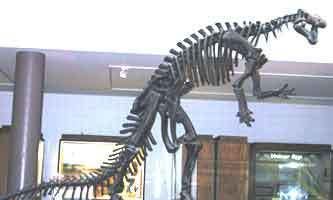 | ||
In the geological timescale, the Berriasian is an age or stage of the Early Cretaceous. It is the oldest, or lowest, subdivision in the entire Cretaceous. It spanned the time between 145.0 ± 4.0 Ma and 139.8 ± 3.0 Ma (million years ago). The Berriasian succeeds the Tithonian (part of the Jurassic) and precedes the Valanginian.
Stratigraphic definition
The Berriasian Stage was introduced in scientific literature by Henri Coquand in 1869. It is named after the village of Berrias in the Ardèche department of France. The largely non-marine English Purbeck Formation is in part of Berriasian age. In fact, the first rocks to be described of this age were the beds of the English Purbeck Formation, named as the Purbeckian by Alexandre Brongniart in 1829 following description by Henry De la Beche, William Buckland, Thomas Webster and William Henry Fitton.
The base of the Berriasian, which is also the base of the Cretaceous system, has traditionally been placed at the first appearance of fossils of the ammonite species Berriasella jacobi. But this is a species that has a stratigraphically problematic and geographically limited distribution. A global reference profile (a GSSP) for the Berriasian has been under active consideration by the International Subcommission on Cretaceous Stratigraphy (ISCS) of IUGS. A range of contender GSSP localities has been studied in detail by the ISCS's Berriasian Working Group including localities as far apart as Mexico, Ukraine, Tunisia, Iraq and the Russian Far East. Several markers have been employed to refine correlations and to work towards defining a base for the Berriasian Stage. These include calcareous nannofossils, such as Nannoconus, calpionellids, ammonites, palynological data and magnetostratigraphy, notably magnetozone M19n. The calibration of these markers, especially Nannoconus steinmannii minor, N. kamptneri minor, and Calpionella alpina, within precisely fixed magnetozones give greater precision in trying to identify the best position for a boundary. In June 2016, the Berriasian Working Group voted to adopt Calpionella alpina as the primary marker for the base of the Berriasian Stage.
In the westrn part of the ocean of Tethys, the Berriasian consists of four ammonite biozones, from top to bottom (latest to earliest):
The top of the Berriasian stage is defined by the base of the Valanginian, which is fixed at the first appearance of calpionellid species Calpionellites darderi. This is just a little below the first appearance of the ammonite species Thurmanniceras pertransiens.
